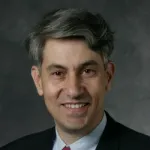
Stanford Report - June 17th, 2009 - by Ruthann Richter
Eighteen medical school projects that had been stalled by budget shortfalls at the National Institutes of Health are moving forward now, thanks to $6.9 million in federal economic stimulus funding.
Eleven of the projects had already been peer-reviewed and approved but hadn't received money yet. Another six involved supplemental grants to existing projects. And in one case, the NIH awarded $500,000 to a researcher to buy two photon microscopes to be shared with other labs. These projects are the first at the medical school to receive support under the stimulus plan, with additional grants expected down the road.
"This is a lifesaver," said Francis Blankenberg, MD, associate professor of radiology and of pediatrics, who received $655,000 in stimulus funds. "It really stabilizes the lab." He and his colleagues are working on a novel radiotherapy approach to targeting breast and colon tumors. The technique uses a radiolabeled form of the protein called VEGF (vascular endothelial growth factor) to selectively target and destroy tumor vessels along with the tumor itself. The researchers initially had applied for a grant in 2007 and after two more resubmissions received a score in the 21st percentile. The cutoff was at the 15th percentile.
"In the old days, they probably would have funded it," he said, but the project remained temporarily sidelined by the stiff competition for limited NIH money. The money will pay for two postdoctoral scholars, as well as Blankenberg and another faculty member part-time.
Philip Pizzo, MD, the dean of the School of Medicine, said the stimulus funding is critical to the country's health-care reform effort because of the linkage between research and medical care. "After six years of NIH funding that constantly lost its value against inflation—with a profoundly negative impact on our nation's prized biomedical research enterprise—the stimulus funding is helping to take research off life support and breathe new hope for work that we hope will ultimately improve the lives of adults and children," Pizzo said.
Roland Bammer, MD, assistant professor of radiology, said his $790,000 grant was a "big relief." He explained: "This was the application that was dearest to my heart, but I had difficulty funding it. The NIH budget went down roughly 10 percent, so 90 out of 100 grant proposals were rejected in the past. It was tough." He will use the funds for a project aimed at improving the technology involved in diffusion tensor imaging. DTI is a form of magnetic resonance imaging that provides more detailed information about the brain and other body structures, such as the heart and prostate, than traditional MRI. It may help to detect early strokes, as well as brain tumors and other brain abnormalities, he said.
Bammer said the stimulus funding will enable him to pay the salaries of several full- and part-time employees.
The biggest of the grants is a $1.6 million award to Amar Das, MD, PhD, assistant professor of medicine and of psychiatry and behavioral sciences, for a project funded by the National Library of Medicine. His goal is to develop methods to allow scientists to understand disease patterns by extracting time-related and other useful information from large databases. For instance, he has been working with the National Database for Autism Research, helping researchers examine when neurodevelopmental problems arise and how they relate to biological markers and imaging findings.
Das said the grant originally was submitted as a three-year project, but that he compressed it into two years to fit the stimulus program guidelines. With the money, he is planning to hire two new staff, a software engineer and a postdoctoral scholar at the Stanford Center for Biomedical Informatics Research.
Ann Arvin, MD, the university's vice provost and dean of research, also received a grant of $444,000 for a project on the herpes simplex virus, which causes cold sores. She and colleagues have developed an animal model to help understand how the virus infects certain nerve cells. "It had been submitted (last July) as a small-scale, two-year proposal and as such, fit very well with the goal of funding two-year projects," said Arvin, professor of pediatrics and of microbiology and immunology.
Arvin said the national stimulus program is important in that it will allow the university to preserve jobs in scientific research. "During these difficult times, to be able to have people employed in science is really very important," she said.
The grants also will allow for continuity in the education of postdoctoral scholars and graduate students who might otherwise be unemployed. In addition to postdocs working in the recently funded labs, two received direct grants: James Blair, PhD, in developmental biology, and Elaine Trepagnier, PhD, in biochemistry.
Others who received funding are: Xiaoyuan Chen, PhD, associate professor of radiology; Mark Davis, PhD, professor of microbiology and immunology; David Feldman, MD, professor emeritus of medicine; Aaron Hsueh, PhD, professor of obstetrics and gynecology; Stuart Kim, PhD, professor of developmental biology; Michael Longaker, MD, professor of plastic and reconstructive surgery; Minnie Sarwal, MD, professor of pediatrics; David Stevenson, MD, professor of neonatology; Alejandro Sweet-Cordero, MD, professor of pediatrics; and Kenneth Weinberg, MD, professor of pediatrics. For more detail, please visit http://med.stanford.edu/news_releases/2009/june/stimulus.html.






